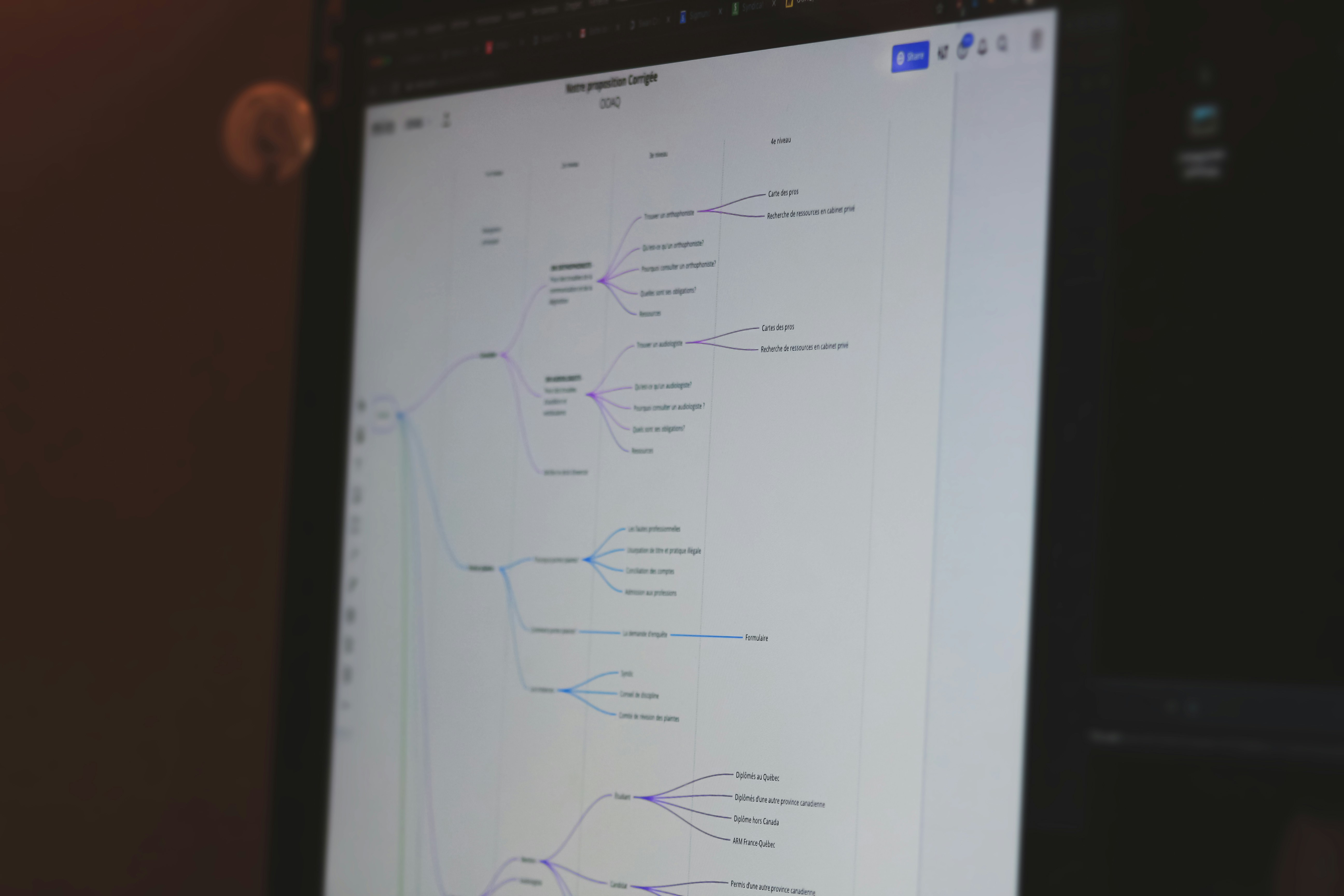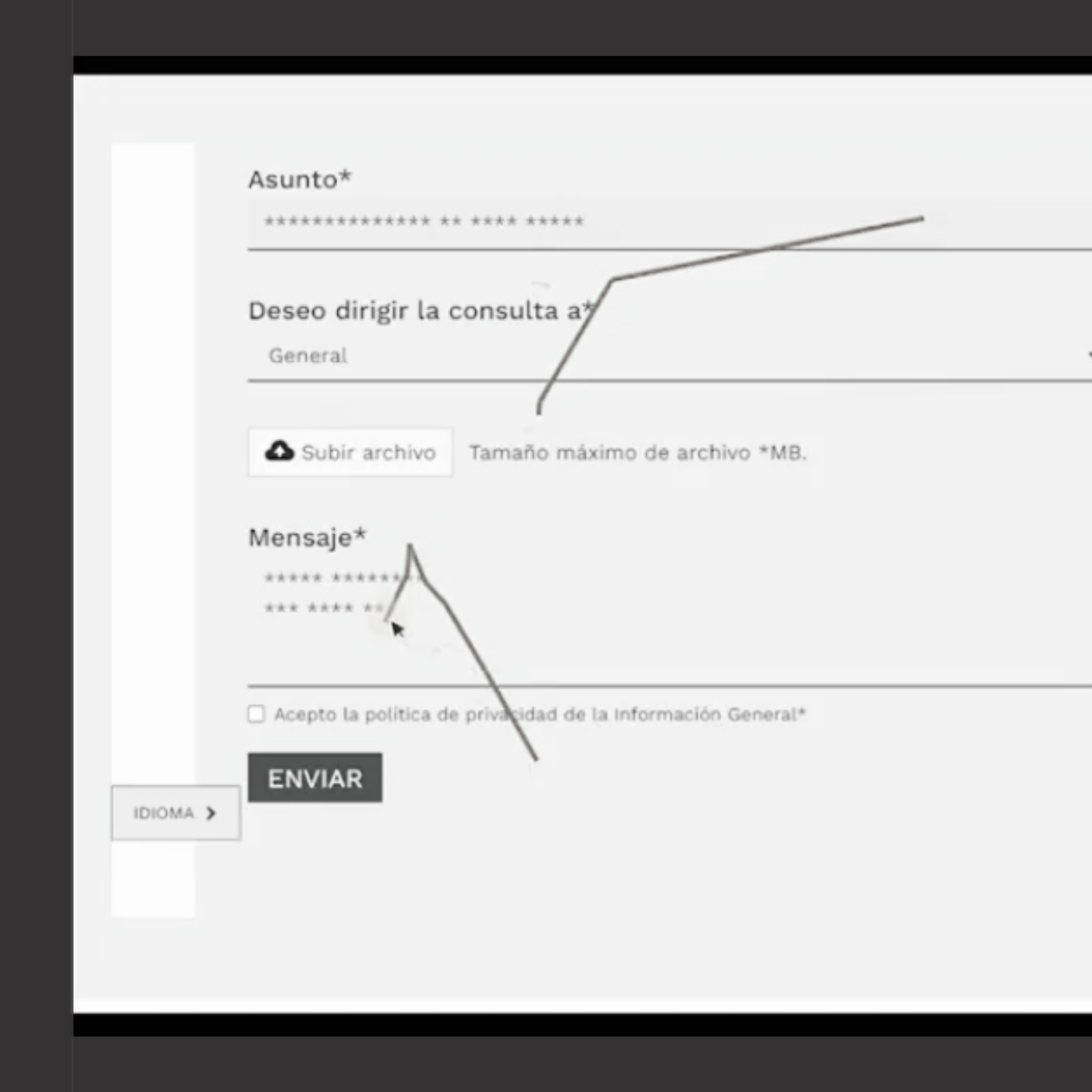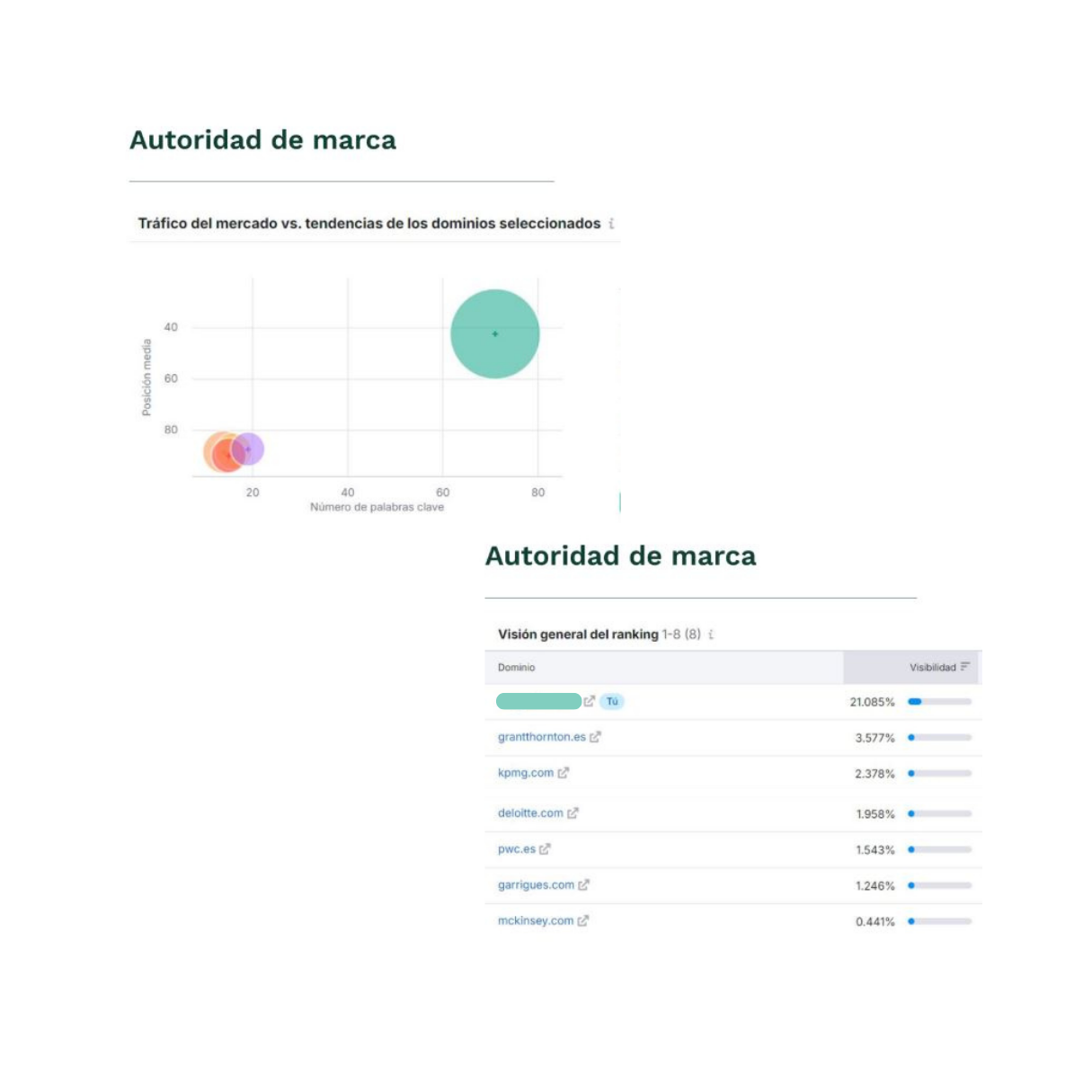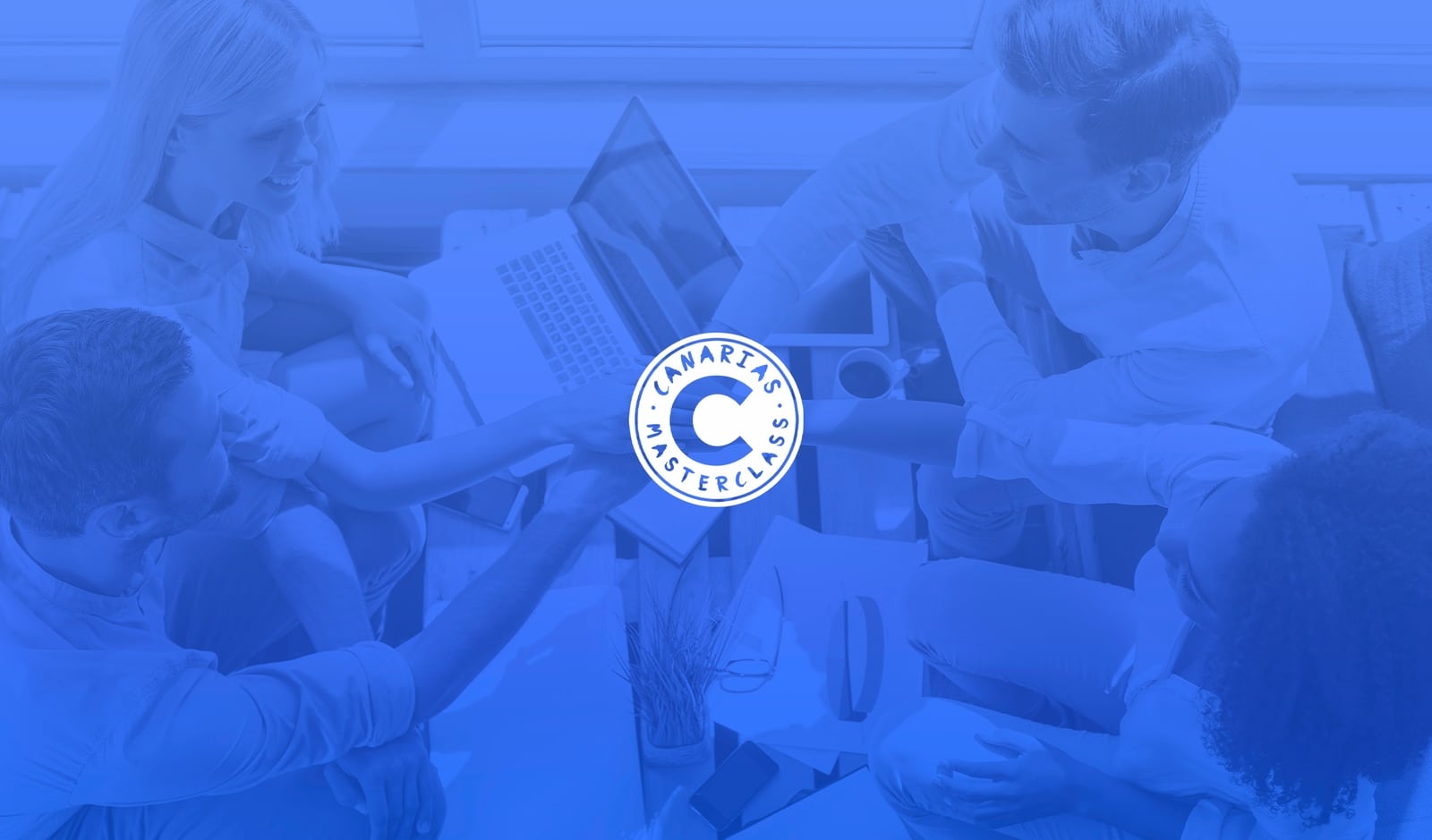* NOTE: Due to the nature of the project and the sensitivity of the industry, the client's identity has been withheld from public view.
1. The Context
Building digital trust in a market ruled by legacy and perception
Relevance in a market ruled by legacy and perceptionIn a space dominated by the Big Four and firms with decades of authority—where digital visibility often correlates with perceived credibility—a boutique consultancy specialized in Corporate Finance, Legal & Tax Advisory, and Interim Management set out to strengthen its positioning through digital channels.
Their offline reputation was impeccable, built on a combination of deep expertise, senior-level involvement, and close client relationships grounded in trust. But were those same qualities resonating with equal strength online?
We began by analyzing the competitive digital landscape to understand where the firm stood—and where the real opportunities were. Where could we position ourselves digitally? Could we reflect the firm’s real-world authority in the digital space as well?
The client had the kind of depth and integrity that, if well represented, we knew would resonate. Our approach was simple: listen, learn, iterate—again and again—until the digital expression matched their real-world excellence


2. The Challenge
What was the real context for activating our services?
Could we realistically compete—digitally speaking—with firms holding such consolidated domain authority as Garrigues, Deloitte, or PwC, backed by massive volumes of content and decades of brand presence?
To uncover real opportunities, we needed to deeply understand:
– Where are decision-makers mentally and emotionally when the need arises?
– What signals, platforms, or language do they rely on to feel confident in a choice?
– How do they interpret credibility and specialization in a high-risk service context?
– What patterns of doubt, friction, or reassurance shape their search and evaluation process?
What does it feel like to be in a CEO’s shoes at a critical decision point?
What emotional, cognitive, or relational filters might delay or accelerate action?
And most importantly: what kind of experience, message, or structure would help them recognize real value and build trust—beyond polished appearances or SEO visibility?
3. Sketch of a Strategy
Hiring decisions in this space rarely follow a straight line—they often begin with informal vetting, quiet searches, and emotional filters. Google isn’t just a search tool here: it acts as the first proxy for trust.
That’s why we grounded our approach in user behavior from the start.
Instead of trying to compete with major players on scale or visibility, we focused on what truly mattered to our audience: clarity, credibility, and a sense of confidence in choosing a boutique partner.
Behavioral patterns revealed a gap: certain high-stakes subtopics were under-addressed, even though they triggered precise, emotionally charged searches. These were moments when decision-makers felt the pressure to find someone trustworthy—without broadcasting their need.
We shaped the strategy around those moments.
Rather than a generic presence, we designed a precise and human-centered narrative—speaking directly to the risks, doubts, and motivations behind the search.
.jpg)

4. Grounding the Strategy
Mapping decision-making behavior to shape digital relevance
To truly understand how and why senior decision-makers choose a firm like this—especially in contexts where trust and discretion are non-negotiable—we combined several research layers: internal interviews, behavioral analytics (Google Analytics + Hotjar), desk research, and competitive analysis.
We weren’t just looking for keywords; we were looking for decision logic.
We tracked not only what executives searched for, but how, when, and why. What emotions surfaced? What barriers did they encounter? What expectations shaped their path?
This process helped us trace their real journey: a mix of rational inquiry and emotional validation—where subtle cues like page structure, consultant bios, and tone had disproportionate weight in building or breaking trust.
A strategy shaped by behavior, not volume
Instead of chasing visibility through high-volume keywords, we prioritized precision:
- Terms that reflected moments of high cognitive load and emotional stakes
- Queries aligned with their real-world language and search intent
- Gaps in the landscape where boutique-level clarity and relevance could outperform corporate noise
Turning existing expertise into clarity tools
The consultants already had the substance—deep expertise, great content, and real-world cases.
Our task was to translate it into a user experience that responded directly to unspoken concerns:
What does this firm really offer me? Can I trust them with this kind of problem? Will they understand the nuance of my case?
We reframed the site as a consultative space—structured around credibility cues, decision logic, and behavioral intent. Each section became a signal of relevance and reassurance.
Bringing their differentiators into focus
What set this firm apart wasn’t volume or visibility—it was the intimacy of their processes, the depth of their support, and the seniority involved in every engagement.
We made sure these differentiators were not just stated, but felt—through clear language, carefully layered structure, and behavioral validation at every step.
5. Iterative Execution
Where decisions meet behavior: a modular, evidence-led approach
Each strategic service—whether Corporate Finance or Interim Management—was treated as a standalone unit for exploration and refinement.
We didn’t start by writing content. We started with hypotheses:
What do users need to understand here? What are they trying to validate? What triggers hesitation—or trust?
Each page became a space to observe, adjust, and fine-tune—not through templates, but through structure, tone, and focus aligned with the type of decision the user was navigating.
Behavior-led iteration: continuous loops of insight and response
Instead of assuming what mattered, we observed:
– Which sections drew deep attention (e.g., advisor bios)
– Where users slowed down—or dropped off
– What journey patterns revealed friction, doubt, or confusion
These signals shaped our next moves.
We added industry-specific examples when patterns diverged (e.g., interim roles in industrial vs. tech contexts).
We restructured content flows based on scroll depth, heatmaps, and interaction logic—not assumptions.
Every change was rooted in real-time behavior: Hotjar, GA, CTR, and user journey dynamics.
The process became a living system—where each refinement reflected not just what users did, but how they thought, hesitated, and decided.
The result: a digital experience tuned to decision-making reality, not marketing convention.

Impact
Behavior-informed content strategy led to +20 #1 rankings in high-impact searches
Including high-value generic queries such as ‘consultora m&a’—a term with high transactional intent—and multiple geolocated variations of key services. By designing each page to directly address the emotional and informational needs behind these queries, we aligned with how decision-makers interpret trust and relevance—earning top positions in Google through UX clarity, not keyword volume.
21% organic visibility reached for strategic business terms — outperforming major industry players
Through iterative research and content refinement, the firm outperformed top-tier competitors like Deloitte, KPMG, and Garrigues in a targeted set of high-impact queries — where each of those firms held less than 3% visibility. By shifting from generic messaging to precision-aligned, behavior-informed content, the boutique consultancy became discoverable at critical decision points for its ideal audience. (See IMG point 6.)
Behavioral insight turned into meaningful engagement—fueling international client conversion
Organic search accounted for 63% of total traffic, with 40% new users and over 60% meaningful engagement.
By continuously refining the UX and messaging based on Hotjar, Google Analytics, and real feedback loops, we built a journey that matched how executives think, evaluate, and commit—proving that UX research can directly influence lead quality in complex B2B environments.

6. Two UX Research reminders I keep coming back to
Google is all about user experience
At its core, Google is a relevance engine—one that surfaces results not just based on keywords, but on how well they align with real human needs, intent, and behavioral signals.
From a UX Research lens, this means SEO isn’t just visibility—it’s a diagnostic tool. It helps uncover how people think, what they fear, and how they frame their problems when no one is watching.
Behavior is the clearest signal
Tools like Hotjar, Google Analytics, and scroll maps aren’t just performance metrics—they’re windows into mental models, emotional friction points, and trust triggers. Iterating based on these behaviors allowed us to reduce uncertainty, adapt to decision logic in real time, and build a digital experience that felt coherent and credible to the users it aimed to serve.
Content was the surface—but clarity, trust, and user logic were the architecture beneath it.


An Outstanding Team
I approached this project as part of a team I shared nearly four years of my life with.









